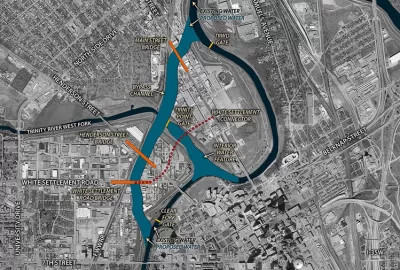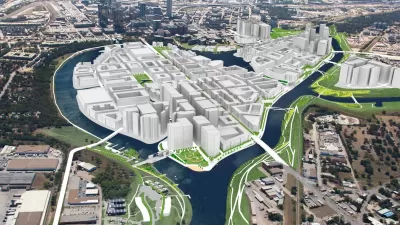Originally planned as a primarily residential development, the riverfront development could shift to a focus on entertainment, commerce, and outdoor recreation.

A massive riverfront district in Fort Worth, Texas could be up for a reimagining after a new report that calls on the city to reconsider the plan for the area. Jenny Rudolph, Harrison Mantas, and Abby Church outline the report’s findings in the Fort Worth Star-Telegram.
As the article explains, “The $1.1 billion public investment to mitigate Trinity River flooding by building new channels will open up more than 5 miles of shoreline and 200 acres for development just north of downtown. As originally conceived, Panther Island’s development would be focused on dense residential buildings with some commercial.”
Now, the report from a consultant firm calls for more mixed-use development in Panther Island and “stresses the need for a unified development strategy for the more than 500 acres of public and privately owned land, as well as the need to avoid displacing surrounding communities such as the historic North Side.”
“Planners are moving away from the residential-focused original plans and instead envision a district with a vibrant entertainment hub, outdoor recreation and the potential to attract companies and talent to the city, HR&A’s report said.” The report adds that the district should be pedestrian-friendly, accessible, and have a “recognizable and distinct identity while also complementing the adjacent downtown and connecting seamlessly with surrounding neighborhoods.”
According to the article, “Although conceived years ago, the project got an official greenlight in January 2022 when the U.S. Army Corps of Engineers received $403 million from the federal government to create the bypass channel connecting two sections of the Trinity River.”
FULL STORY: The vision for Fort Worth’s Panther Island is changing. Here’s what a new report says.

Planetizen Federal Action Tracker
A weekly monitor of how Trump’s orders and actions are impacting planners and planning in America.

San Francisco's School District Spent $105M To Build Affordable Housing for Teachers — And That's Just the Beginning
SFUSD joins a growing list of school districts using their land holdings to address housing affordability challenges faced by their own employees.

The Tiny, Adorable $7,000 Car Turning Japan Onto EVs
The single seat Mibot charges from a regular plug as quickly as an iPad, and is about half the price of an average EV.

Seattle's Plan for Adopting Driverless Cars
Equity, safety, accessibility and affordability are front of mind as the city prepares for robotaxis and other autonomous vehicles.

As Trump Phases Out FEMA, Is It Time to Flee the Floodplains?
With less federal funding available for disaster relief efforts, the need to relocate at-risk communities is more urgent than ever.

With Protected Lanes, 460% More People Commute by Bike
For those needing more ammo, more data proving what we already knew is here.
Urban Design for Planners 1: Software Tools
This six-course series explores essential urban design concepts using open source software and equips planners with the tools they need to participate fully in the urban design process.
Planning for Universal Design
Learn the tools for implementing Universal Design in planning regulations.
Smith Gee Studio
City of Charlotte
City of Camden Redevelopment Agency
City of Astoria
Transportation Research & Education Center (TREC) at Portland State University
US High Speed Rail Association
City of Camden Redevelopment Agency
Municipality of Princeton (NJ)




























